The Apple iPad Pro Review
by Ryan Smith, Joshua Ho & Brandon Chester on January 22, 2016 8:10 AM ESTBattery Life
Battery life is important beyond any doubt. No one wants a tablet or phone that can only spend three hours away from a charger before it dies, no matter how good the device is. While such battery life might be incredible for a desktop replacement or anything else that realistically spends most of its life plugged into a charger, mobile devices are usually carried on the go and used far away from a charger for significant amounts of time. Probably the ultimate example of this is travel, where one might use a tablet to watch movies and browse the internet for a few hours over the course of a flight.
As a result, a significant portion of our reviewing efforts are devoted to determining battery life. In order to quantify battery life, there are inevitably a lot of test cases to cover. Some people might spend most of their time in an e-reader app, others might spend most of their time playing games or similarly intensive tasks on their phones. There’s no real standard for usage, so a tablet that might last a day for one person could last a week. As a result, the goal of our testing is to provide a useful relative comparison. In order to do this, we attempt to equalize for variables like display brightness by setting all displays to 200 nits for battery life testing. Due to the inability to completely eliminate the variables that come with live network testing, we also use strong network reception with high throughput on LTE to ensure that things like power amplifiers are either at a low power setting or bypassed entirely.
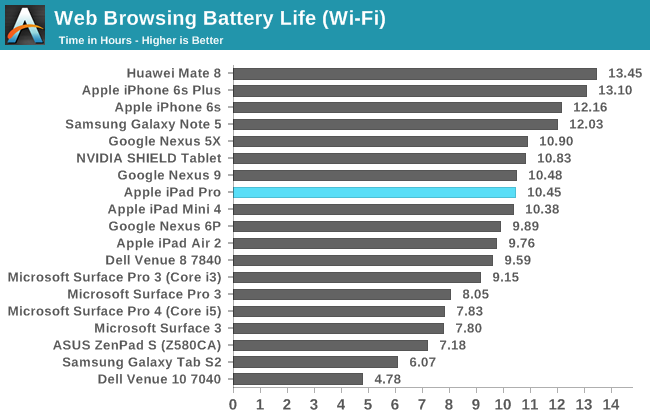
Our first test is the venerable web browsing test, in which we load a selection of web pages from full charge until the device shuts off from lack of battery charge. In WiFi battery life is pretty much identical to the iPad Air 2, which might be surprising given that the battery is only 41% larger. That might sound like a lot, but the display of the iPad Pro is 77% larger at the same 264 PPI pixel density, which means that there’s a pretty sizeable efficiency gap between the iPad Air 2 and iPad Pro. The improved display and SoC are likely to be the main reasons for this, as the 20nm SoC process that was used to make the A8 SoC was quite leaky due to its traditional planar transistor structure compared to the FinFET process used in the A9X.
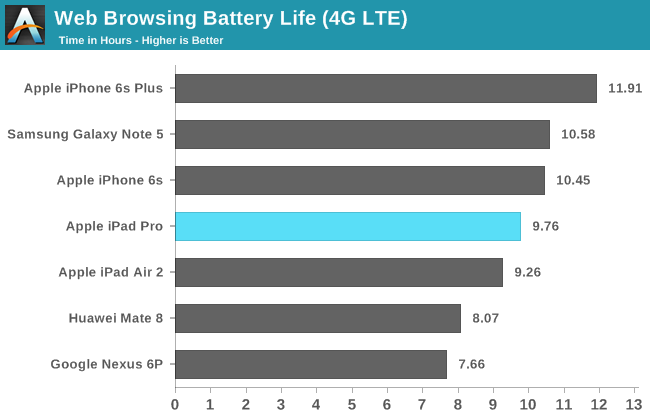
Interestingly, for whatever reason when re-running the same test on LTE battery life is noticeably different when compared to the iPad Air 2, where LTE and WiFi battery life were relatively close. I suspect that RF power is pretty similar between the two devices, but due to efficiency improvements on the display/SoC side the difference in battery life due to additional RF power consumption is magnified.

The more interesting test result that I encountered over the course of battery life testing was our tablet video rundown test. For whatever reason, web browsing clearly lasts a decent amount longer. It's pretty unlikely that the web browser has a lower SoC load when video is basically entirely dependent upon fixed function hardware decode. The most plausible explanation here for me is that we're seeing differences that arise from panel self-refresh, which can kick in on our web browsing test while the same definitely doesn't hold for our video test, which basically requires at least 30 FPS refresh rate continuously for the entire duration of the test. Overall that this makes the iPad Pro worse for content consumption, given Apple's content creation goals, is an unexpected turn of events.
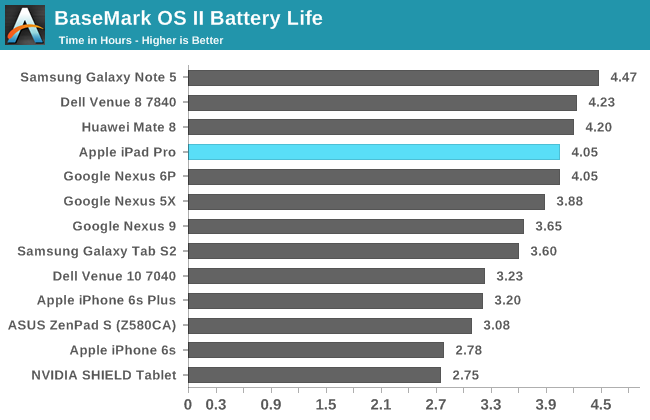
Moving on to the more SoC-bound tasks, we can start by looking at Basemark OS II, which is basically a CPU power virus that can be used to examine the upper bound for device TDP, in addition to nominal sustained CPU load. It’s evident from this test and some back of the envelope calculation that total device TDP excluding display power is roughly 5W, which is about right given the size of the device. This suggests that the A9X can be directly compared to Intel’s Core M in both performance and power, for better or for worse. Performance here is good, with relatively low throttling due to the use of a FinFET process and solid implementation of the Twister architecture.

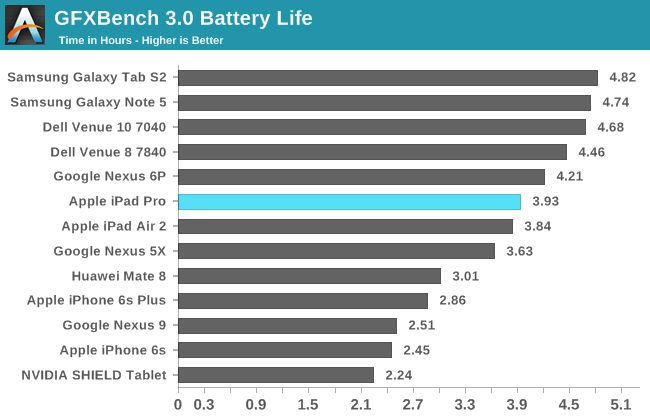
In our GPU throttling test, the A9X has effectively made it impossible to actually use T-Rex as a throttling test as it’s essentially pegged at vsync for the entire duration of the test. The iPad Pro also lasts a similar amount of time here as on the Basemark OS II test, which suggests that this test is still reaching TDP limits for the GPU, even if it doesn't manifest in the form of reduced performance.
Charge Time
While battery life is important, any time you’re dealing with a mobile device the time it takes to charge the battery is important as well. The usual example here is travel, but simply forgetting to plug in a device overnight can show the importance of charge rate. In the case of the iPad Pro, Apple ships it with their usual 12W charger. One might be tempted to suggest that the battery would be charged in about 3.5 hours, but it’s necessary to get the data and avoid speculation on something like this. In order to test how quickly the iPad Pro charges, we measure the difference in time between first plugging in a fully discharged tablet and when the charge is complete based upon power draw at the AC adapter.
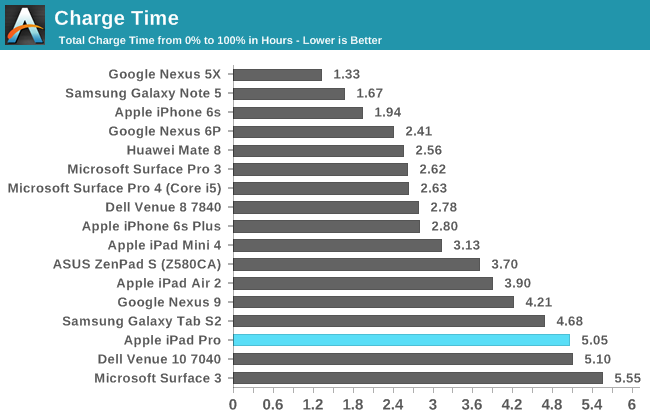
Interestingly, the iPad Pro takes a pretty significant amount of time to charge, at over a full hour longer than the iPad Air 2. While some might be okay with this, it’s definitely a sore spot for the iPad Pro as a higher voltage charger would be able to charge the device at a more acceptable rate. I’m not really sure why Apple decided to go this route, but there’s really no clear solution here unlike the case of the iPhone 6s Plus. The charger also definitely isn’t enough to ensure that you’re always charging the iPad Pro while in use either if the SoC is in overdrive/turbo states as thermally constrained power draw is already around 9-10W.
Despite the long charge time, overall the iPad Pro is quite mobile. However, it does regress somewhat relative to the iPad Air 2 due to its longer charge time, even if battery life is equivalent. Depending upon your use case though it might be difficult, if not impossible to tell the difference.











408 Comments
View All Comments
Valantar - Tuesday, January 26, 2016 - link
I have to say I'm a bit confused by the large portion of this review comparing the iPad Pro to the Pixel C, all the while nearly neglecting the Surface Pro 4. You have a long section praising the pen experience with the Pencil, without a single comparison to the (included) Surface Pen? That's just weird. Sure, the SP4 runs a full desktop OS, but it's a far more natural comparison in terms of size, weight, power and compatible accessories. I get that not all of your reviewers can get access to every product, but for the sake of that part of the review, acces to a SP4 would have been essential.Constructor - Tuesday, January 26, 2016 - link
I'm not defending this review necessarily, which is a bit odd and lacking in some regards, but there are various interesting Youtube demonstrations and reviews which make exactly that comparison.This is an interesting comparison of tracking accuracy and latency: https://www.youtube.com/watch?v=niD1N1d4nTc
This is from a designer's perspective:
https://www.youtube.com/watch?v=YaO_ucAZ4dQ
And comparing iPad Pro, Surface Pro 3 and Wacom Cintiq:
https://www.youtube.com/watch?v=JlspvcF-DKs
glenn.tx - Wednesday, January 27, 2016 - link
I agree completely. It's quite disappointing. The comparisons seem to be cherry picked.bebby - Tuesday, January 26, 2016 - link
What I miss in the discussion and review so far is the fact that google obviously does not yet support the higher resolution of the ipad pro for their apps. I wonder if there is intent behind that. It is very annoying as a user.Google is getting more and more important as a software/app provider but so far they have not been successfull with any of their hardware ventures (motorola, google glass, tablets, etc.).
ipad pro would be perfect with working google apps.
Constructor - Tuesday, January 26, 2016 - link
Looks like Google doesn't want to be seen boosting the competition's platform even though that's where they make most of their money on mobile, ironically.(Can't say I'd miss any of their software, though. Apart from an occasional picture search I'm not using any of it.)
Not that Apple is falling all over themselves in making software for other platforms either (even if they sporadically do, for their own purposes).
Zingam - Tuesday, January 26, 2016 - link
A Chargeable Pen? Apple's sense of humor never fails to amaze me!Constructor - Tuesday, January 26, 2016 - link
Which other pen with the same capabilities (zero-calbration pixel-precise resolution + pressure + tilt + orientation, near-zero latency, near-zero parallax) a) even exists and then b) does not need its own power supply?phexac - Tuesday, January 26, 2016 - link
The only way I would call this device "Pro" is if I could actually use it at work. I drive a bulldozer and, though I've tried, digging ditches with iPad Pro is terribly inefficient, and that's a problem that I don't see software makers fixing any time soon for a touch only device. Furthermore, the charging port has compatibility issues and would not accept the hose I use to refuel the bulldozer. To add insult to injury, you cannot sit on the iPad while using it! I couldn't help chuckling at the expectation that Apple apparently has for its consumers to either stand or kneel while SUPPORTING THE IPAD'S weight and trying to use it to move a mound of gravel at the same time.Finally, I have found in my experiments that even adding a keyboard to this device does not solve the problem. I have tried both the Apple iPad Pro keyboard and a Bluetooth one I could use wirelessly while sitting on a stack of cement bags. iPad lacks the basic ability to self-propel around the construction site and requires me to carry it from one task to another.
Better luck next time, Apple! I will stick with my Caterpillar earthmover!
Constructor - Tuesday, January 26, 2016 - link
Yep. The exact same argumentation as above in many cases! B-)althaz - Tuesday, January 26, 2016 - link
What I don't understand is the constant comparisons to the Surface Pro 3 - particularly in terms of the keyboard which changed quite significantly with the Surface Pro 4 (the pen also changed significantly).